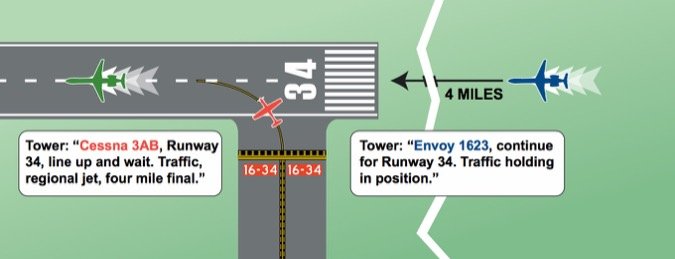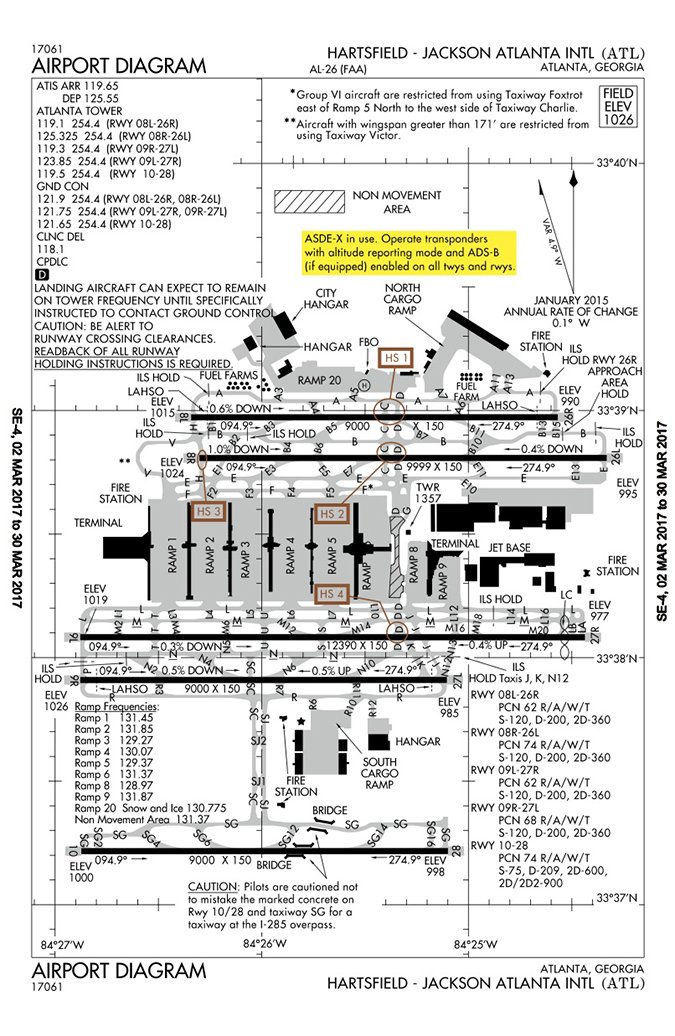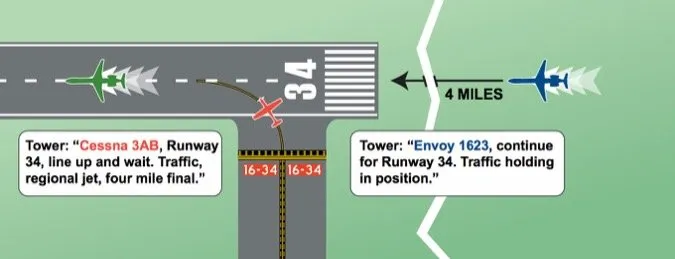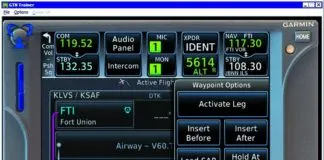You’ve probably heard the morbid axiom: FAA regulations are written in blood. Many of the rules fattening the books governing pilots and air traffic controllers were brought about by unfortunate incidents.
“Line up and wait” (LUAW) is a significant example. It’s an inherently risky maneuver: a controller places an airplane on a runway but doesn’t let them take off due to other traffic using the runway or on final to that same runway. While saving precious time—the essence of ATC ops—things can go south if it’s not managed properly. We are, after all, talking about placing non-moving airplanes on the one piece of concrete every other airplane in the vicinity wants to use.
The worst-case scenario occurred the night of Feb. 1st, 1991. Los Angeles International Tower put SkyWest 5569—a Metroliner turboprop—into LUAW at an intersection on Runway 24L. The airport’s surface radar wasn’t working. The controller was working some ground-control duties and didn’t have SkyWest’s paper flight progress strip to keep them on her mind.
She became distracted by a third aircraft. She cleared USAir 1493, a Boeing 737, to land on 24L. The USAir crew didn’t see SkyWest blending into the airfield lights. The 737 crushed the Metro; both flaming aircraft slid into a building, killing 35 people, including all 12 aboard the Metroliner.
That dark night was over 25 years ago. However, you can still hear its echoes every time ATC uses line up and wait. Accidents like that inspired many regulations, training, good judgment, and technology that reinforce safer operations today.
Mission: Efficiency
Seconds matter in air-traffic operations. Major airports like Atlanta (KATL) and San Francisco (KSFO) plan each aircraft with only 60 seconds on the runway to take off or land. While one aircraft is either rolling out or departing, another is lining up for departure. Any time saved benefits everyone, regardless if the airport handles airliners or piston Cessnas. Without LUAW—pronounced “Luau,” like the Hawaiian feast—delays would pile up nationwide.
FAA Order 7110.65 section 3-9-4, describes LUAW: “The intent of LUAW is to position aircraft for an imminent departure. Authorize an aircraft to line up and wait… when takeoff clearances cannot be issued because of traffic.” While ATC may be unable to clear you for takeoff immediately due to other aircraft, we can at least get you on the runway and ready to go.
But we can’t substitute efficiency for safety. For instance, a big rule for LUAW is: “Do not use conditional phrases such as ‘behind landing traffic’ or ‘after the departing aircraft.'” Sure, ATC does occasionally pass separation responsibility on to pilots, whether it’s telling one taxiing aircraft to “give way” to another, or “maintain visual separation” in the air.
A runway, however, is a tightly controlled, volatile environment, where pilots are highly-focused on landing or takeoff. The phraseology is pure and ATC assumes all responsibility for clearing aircraft to LUAW. Also, if an aircraft is in position, we can’t clear it for takeoff until the preceding aircraft completely clears the runway.
Now, we can anticipate separation all the time, based on aircraft characteristics. If I know a departure will be slow taxiing onto the runway—like most airliners—I might tell him to LUAW just before landing traffic crosses the threshold. The LUAW won’t even start moving until the lander passes.

A Wall of Words
LUAW ops demand considerable judgment. As backup, certain larger airports have expensive “safety logic systems” to provide oversight and conflict warnings. Airports without a budget for those systems—most general aviation, military, and regional fields—must rely simply on human situational awareness.
Stricter rules replace the tech. For “facilities without a safety logic system or facilities with the safety logic system in the limited configuration,” 7110.65 3-9-4 c. 1. is clear: “(a) Do not issue a landing clearance to an aircraft requesting a full−stop, touch−and−go, stop−and−go, option, or unrestricted low approach on the same runway with an aircraft that is holding in position or taxiing to line up and wait until the aircraft in position starts takeoff roll.”
Say you’re lined up on the runway, waiting for your takeoff clearance. You hear the controller clear someone to land on the same runway you’re occupying… and you’re not allowed to move. I’d be wishing for at least a rear-view mirror.
That rule is a built-in safety net. No inbound aircraft can legally touch the runway without ATC authorization. Withholding landing clearance until “the aircraft in position starts takeoff roll” throws up a virtual wall to prevent catastrophe. Sometimes a squeeze play doesn’t work out. Maybe an aircraft takes too long to start rolling or ATC’s radios fail (I’ve been there). Without a landing clearance, the inbound has to go around. If they touch runway, at best, it’s a pilot deviation. At worst…
There’s a sequel: “(b) Do not authorize an aircraft to LUAW if an aircraft has been cleared to land, touch−and−go, stop−and-go, option, or unrestricted low approach on the same runway.” If someone’s already cleared to land on a runway, LUAWs aren’t allowed.
Why, then, if you’re holding short of the runway, can you be cleared for takeoff with traffic on final? An easy explanation: a LUAW instruction, per its intent, prevents you from moving further down the runway. With a takeoff clearance, you just go.
If you’re inbound and ATC puts traffic in LUAW, the proper phraseology is a throwback to the old phraseology “taxi into position and hold.” “N123AB, continue,. Traffic will be holding in position.”
What if ATC already cleared you to land and then LUAWs someone? “Cancel landing clearance. Continue. Traffic will be holding in position.” Then they’ll LUAW the other guy. Once he’s moving, they’ll re-clear you to land. You can have LUAW or a landing clearance, but not both without technological backups.
Everyone Aware of Everyone
LUAW safety is built upon situational awareness. Naturally, controllers must tell you about other traffic that could affect you during LUAW ops.
“When an aircraft is authorized to line up and wait, inform it of the closest traffic requesting a full−stop, touch−and−go, stop−and− go, option, or unrestricted low approach to the same runway.” You’d want to know about anyone barreling down the final towards your tail, right? That’s 7110.65, 3-9-4 subparagraph d.
That pairs up with subparagraph k: “When aircraft are authorized to line up and wait on runways that intersect, traffic must be exchanged between that aircraft and the aircraft that is authorized to line up and wait, depart, or arrive to the intersecting runway(s).” If I line you up on Runway 9, and another aircraft is on intersecting Runway 18, wouldn’t you want to know about the other guy?
Speaking of traffic, we don’t have to tell you about another aircraft if it’s obvious, per 3-9-4 subparagraph a. “Traffic information may be omitted when the traffic is another aircraft which [sic] has landed on or is taking off the runway and is clearly visible to the holding aircraft.” If I clear someone for takeoff or landing, and then LUAW you as soon as the other guy rolls past you, I’m assuming you saw the other aircraft since it just zipped right by your nose.
Want more common sense? Subparagraph f: “Do not authorize an aircraft to line up and wait when the departure point is not visible from the tower, unless the aircraft’s position can be verified by ASDE or the runway is used for departures only.” It’s friends with section h: “Do not authorize an aircraft to line up and wait at any time when the intersection is not visible from the tower.” For both of those, if we can’t see where you are, we shouldn’t LUAW you, unless you’re departing full length and no one’s landing on that runway anyway.
An ATC saying is: “Don’t keep secrets.” By following the regs above, we’re keeping you fully in the loop and staying on top of our traffic.
Electronic Oversight

Towers using LUAW have unique procedures and memory aids to remind controllers when an aircraft is in position. A LUAW aircraft’s flight plan might need to be placed in a certain position on the controller’s console or a special light flipped on. A plastic marker with the words “LUAW” may need to be held until the LUAW aircraft rolls. Seemingly silly, these are effective memory joggers. But, they’re still subject to human error.
At some airports, technology complements human awareness. Airport Surface Detection Equipment, Model X (ASDE-X) is in use at 35 airports nationwide. Its upgraded version, Airport Surface Surveillance Capability (ASSC), was approved for use at an additional nine airports. These systems blend input from multiple sensors—surface-scanning radar, air surveillance radar, ADS-B sensors, aircraft transponders, and others—to track all traffic in the immediate vicinity.
The first three benefits listed for ASSC/ASDE-X are: “1. Helps prevent runway collisions. 2. Improves situational awareness. 3. Covers airport from arrival through departure paths within a few miles of the airport.”
Originally only available to controllers on specialized displays, ADS-B is now pushing that data beyond the tower cab. Per the FAA, “With ASSC/ASDE-X, both controllers and pilots with ADS-B In and cockpit displays see aircraft and ground vehicles on the airport surface, and on approach and departure paths within a few miles of the airport.” Extra situational awareness is always good.
Airports using these systems have different LUAW rules. “Except when reported weather conditions are less than ceiling 800 feet or visibility less than 2 miles, facilities using the safety logic system in the full core alert mode: (a) May issue a landing clearance…, option, or unrestricted low approach to an arriving aircraft with an aircraft holding in position or taxiing to LUAW on the same runway, or (b) May authorize an aircraft to LUAW when an aircraft has been cleared for a full stop, touch−and−go, stop−and−go, option, or unrestricted low approach on the same runway.”
That pile of verbiage really just asks two questions. Is the weather better than 800-foot ceilings and two miles visibility? Does the airport have safety logic equipment—like ASSC/ASDE-X—running at full capability? Yes and yes? Then ATC can simultaneously put aircraft in LUAW while clearing aircraft to land on the same runway. If either of those is a negative, then we’re back to the procedures described previously.
If the safety logic system detects a conflict like an aircraft in LUAW with an aircraft on short final, the triggered alarm startles everyone in the tower. So, in the rare case where it does go off, everyone pays close attention.
Critical Caveats
There is a lot of common-sense in LUAW procedures. LUAW isn’t authorized if the Local position—”Tower”—is combined with another position. Controllers often work combined positions during slower traffic periods. The FAA wants to ensure that controllers running LUAW remain focused on the runways. Thus, LUAW capability may come and go at your airport depending on tower staffing.
LUAW rules are big on stating an aircraft’s position, particularly with intersection departures. “When two or more aircraft call the tower ready for departure, one or more at the full length of a runway and one or more at an intersection, state the location of the aircraft at the full length of the runway when authorizing that aircraft to line up and wait.” Imagine you’re ready at the end of Runway 9, and someone else calls at an intersection. To give you LUAW, I say, “Runway 9, full length, line up and wait.” That “full length” is a reminder to the other guy that I’m not talking to him.
It works the other way, too: “Runway 9 at intersection [taxiway], line up and wait.”
Could I give you both LUAW simultaneously? Actually, yes… but: “Do not authorize aircraft to simultaneously line up and wait on the same runway, between sunrise and sunset, unless the local assist/local monitor position is staffed.” I’d need to staff another controller to assist and monitor me.
Nighttime intersection LUAWs have weighty restrictions. The runway must be used as a departure−only runway, “only one aircraft at a time is permitted to line up and wait on the same runway,” and the operations must be documented in the facility log. These procedures must be contained in the official ATC facility’s directives and approved by the directors of FAA Terminal Operations and Terminal Safety and Operations Support.
Looking back at the USAir/SkyWest accident, what wouldn’t happen today?
- SkyWest was told to LUAW at an intersection, at night, on a runway used for both arrivals and departures.
- SkyWest was not told about the USAir on final and USAir was not told about SkyWest in position.
- USAir was issued a landing clearance with an aircraft in LUAW.
- Ground radar wasn’t operational.
- The tower controller had additional ground control duties sapping her attention.
- The controller didn’t have any memory aids to remind her of SkyWest.
Every one of those factors was addressed in the regulations we discussed, each rule designed to ensure such an accident never happens again. The lessons from the tragedy were learned. Today, “line up and wait” is a fantastic tool that helps controllers move some airplanes. However, the extensive regs reinforce the serious responsibility and intense attention to detail required to make it as safe as possible.
Tarrance Kramer keeps the traffic flowing out in the Midwest. Without LUAW, there’s no way he’d be able to move as many airplanes as he does.





